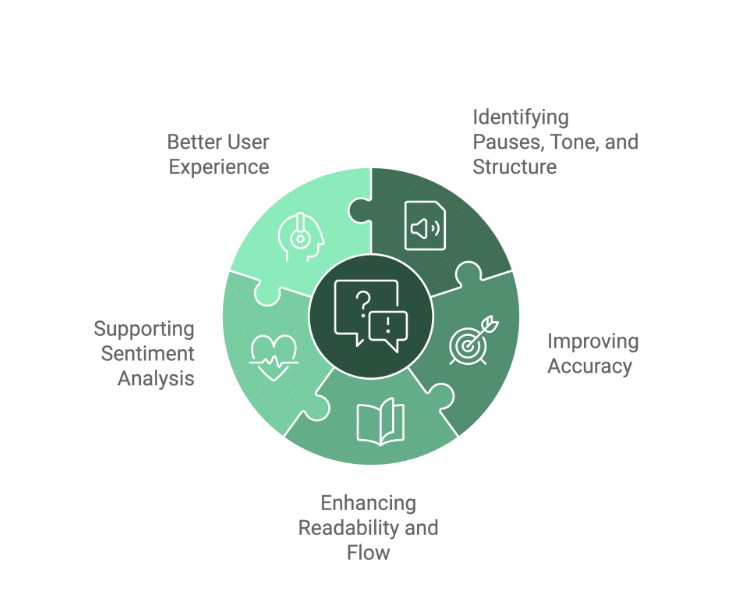We’ve gotten used to various speech recognition technologies that allow us to dictate messages and emails, yet a lot of these systems aren’t perfect. It can be frustrating to go back and correct small mistakes like run-on sentences and capitalization if you’re in a hurry, but the reason these mistakes happen often has to do with punctuation.
It’s easy to dictate a sentence and have it transcribed with relatively high accuracy, but it’s more difficult for speech recognition technology to pick up on when sentences end or when there’s a break. The importance of punctuation in speech recognition could not be more overstated: accurate results rely on a good understanding of how humans speak and corresponding punctuation rules.
In this blog post, we’ll look at what makes punctuation so important in speech technology, including how it works in automatic speech recognition and the challenges these platforms face.
What Is Punctuation?
Punctuation refers to symbols and marks used in written language to clarify a text’s meaning, structure, and tone. Punctuation marks include periods, commas, question marks, exclamation points, quotation marks, and others, each serving a specific purpose in organizing sentences and conveying emotions or intentions.

Why Is Punctuation Important for Speech Recognition Systems?
In automatic speech recognition (ASR) systems, punctuation plays a very important role. Without punctuation, these systems would render outputs that are inaccurate, unclear, and difficult to understand. The transcribed text needs punctuation to grasp the nuance of the original speech to avoid misinterpretation. Below, we’ll look at a few key reasons why punctuation is so critical to speech-to-text platforms.
Identifying Pauses, Tone, and Structure
We don’t speak the same way we write. Speech includes pauses, intonations, and changes in tone that can indicate a shift in meaning or emphasis. With punctuation, it’s easier to mimic these signals in the text that come naturally when speaking, making it easier to organize and understand thoughts and context.
Improving Accuracy
Proper punctuation makes sentences more understandable. Without it, text can become ambiguous, clunky, and difficult to read. A classic example of how punctuation affects readability is how a comma can change a simple sentence: “Let’s eat, grandma,” has a much different meaning than “Let’s eat grandma.”
Enhancing Readability and Flow
Text without punctuation can be more challenging for readers to process, making transcriptions hard to follow. Accurate punctuation makes transcriptions feel more natural and easier to follow as it reflects the rhythm and emphasis of spoken language.
Supporting Sentiment Analysis
Many speech recognition systems are equipped with sentiment analysis features, which look for cues and context in language to detect the sentiment of the speaker. Punctuation marks like exclamation points or question marks are vital for deciphering emotions and intent in a text.
Better User Experience
Voice-based applications like virtual assistants and customer support tools rely on punctuation to deliver a positive user experience. Punctuation enhances the clarity and usability of both an inquiry and the response, helping the user reach the action or answer they were looking for.
Punctuation Challenges in Automatic Speech Recognition
There are many challenges facing ASR systems when it comes to delivering an output with accurate punctuation. Even if an ASR platform transcribes all the words correctly, without inserting capitalization and punctuation marks, it can be very difficult to read. Here are some of the core punctuation challenges in automatic speech recognition.
- Speaker intent: Sometimes, we speak with inflections on specific words that may make the sentence sound like a question or exclamation, when in fact, we’re emphasizing words or topics that are important. It can be challenging for ASR systems to tell the difference in cases like these.
- Impossible to predict future meaning: With live ASR systems, for example, platforms that work to transcribe lectures in real-time, it’s impossible for the system to guess what comes next to figure out the punctuation that should come at the beginning, middle, and end of a sentence.
- Paired punctuation: Punctuation marks that come in pairs, like quotation marks and parentheses, are especially tricky for ASR systems to get right. Platforms would need to know when to insert the first mark before they can understand that the speaker is using a quote or parenthetical.
- Prosody detection: Prosody, which is the patterns of rhythm, sound, and intonation in speech, can be hard to identify. For example, someone may pause for a moment, which an ASR can understand as the end of a sentence, but in reality, people often pause mid-sentence or use run-ons when speaking.
How Does Punctuation Work in Automatic Speech Recognition?
For punctuation to be added to outputs, ASR systems need to adopt new models to assist in providing more accurate results. These models include a few extra steps in traditional ASR systems, but the outcome is a transcript that’s much easier to work with and understand.
Overall, ASR systems that include punctuation function the same way but in the background, and are trained on additional data and models that allow them to create a final, accurate outcome. There are a few changes and updates to typical ASR models that need to occur for this to happen. Here’s a look at what’s different:
- Teams decide on punctuation marks: Before creating new models, teams building ASR systems need to decide on which punctuation marks they’re going to focus on for auto-punctuation. Typically, systems will opt for the most commonly used ones like periods, commas, question marks, and exclamation points.
- Deep learning networks: After deciding on auto-punctuation marks, another level of deep learning is applied through transformer neural networks. These networks get more accurate as they’re trained on more datasets, allowing ASR systems to better understand punctuation.
- Machine learning: ASR systems are trained on large quantities of audio, but in these instances, also on ground-truth transcripts. These transcripts correspond to input training audio so that systems can measure how accurate outputs are.
- Contextual Awareness: Models are trained to understand contextual cues within speech, such as sentence structures and common linguistic patterns, which helps correctly place punctuation marks.
- Domain-specific training: For specialized use cases like legal or medical transcription, systems are trained with domain-specific data to ensure punctuation aligns with the context and terminology used in those fields.
- Real-Time Adaptation: Advanced ASR systems integrate real-time learning capabilities, allowing them to improve punctuation predictions based on live input and feedback.
Enhancing Communication With Punctuation in ASR
Punctuation is fundamental to written communication, which is why it’s so important for ASR systems to handle it accurately. Punctuation improves the usability and effectiveness of ASR outputs in many industries. While the process of adding punctuation to ASR systems involves sophisticated models and technologies, these innovations are going far in capturing the nuances of human speech.
Speech AI is also playing a pivotal role in this change. By leveraging speech AI technologies like aiOla, organizations can benefit from more reliable and intuitive voice-based applications. With systems like aiOla that offer high levels of accuracy, companies can create more seamless interactions between speech, machines, and text, leading to improvements in workflows, data collection, and productivity.
Book a demo today to learn more about how aiOla can help your organization improve communication with a highly accurate voice system.








